Robert Sutton of Stafford
Further images
-
(View a larger image of thumbnail 1
)
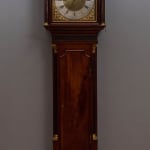
-
(View a larger image of thumbnail 2
)
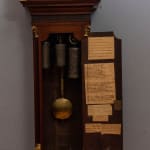
-
(View a larger image of thumbnail 3
)
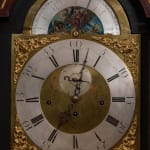
-
(View a larger image of thumbnail 4
)
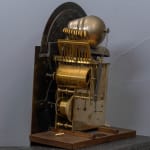
-
(View a larger image of thumbnail 5
)
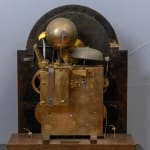
-
(View a larger image of thumbnail 6
)

-
(View a larger image of thumbnail 7
)

-
(View a larger image of thumbnail 8
)
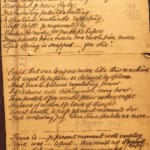
-
(View a larger image of thumbnail 9
)
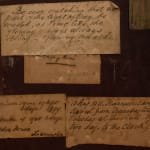
An extremely fine Georgian mahogany musical longcase clock with an annual calendar, showing the saint’s days, holy days and the gods of the four seasons by Robert Sutton of Stafford, engraved with the name Sutton and Stafford on the central brass dial plate, the surrounding silvered dial ring with Roman hour numerals and outer Arabic numerals for the five minute intervals with a pair of shaped and pierced blued steel hands, set within the dial plate is a subsidiary dial marked 1-7 for the days of the week with a stylised blued steel pointer, the demi-lune dial above the main dial centred by a polychrome painted ring depicting the four gods of the seasons and surrounding it, on a silvered dial ring, are the abbreviated names of the months and the number of days within each month and within it the different saint’s days, holy days and historic events to include from January: Epiphany, St Paul, King Charles martyred (30th January) Purification of the Virgin Mary, St Mathias, Easter day, Lady day, St George, St Mark, St Philip, King Charles II’s restoration (May 29th), St Barnabas, the longest day of the year, St John the Baptist, St Peter, St James, Lammas day, St Bartholomew, St Matthew, St Mark, St Luke, St Simon, All Saints day, St Martin, St Thomas, St Stephen, Holy Inn and Circumcision. The movement with ten bells sounded by ten hammers and with a musical movement playing a different tune for each of the seven days of the week (listed below). The mahogany case surmounted by a swan-neck pediment to the hood enclosing brass paterae, flanking a ball-and-spire brass finial, above panels of blind fretwork, with finely fluted free standing pillars to the trunk and hood, each pilaster headed by brass Corinthian capitals, with a shaped top to the door below a carved frieze and with further carved panels to the four corners of the base, the case standing on cabriole bracket feet. The clock bearing a number of pieces of paper attached to the inside of the door bearing the following inscriptions: “Harrison came 29 Sept 1899 3 days/ December 4 1905 2 days. Gordon House Leamington” and “10 Aug 1911. Harrison came & stayed from Thursday till Tuesday at the Bull [?] two days to the clock”. The following describe the tunes played on the musical drum: “Sunday: Innocents/ Monday: The Bluebells of Scotland/ Tuesday: Once I loved a maiden fair/ Wednesday: The Bailiff’s daughter of Islington/ Thursday: Come o’er the stream Charlie/ Friday: My lodging is on the cold ground/ Saturday: The Troubadour’s song” And “Momento Mori/ Onward perpetually moving/ These faithful hands are ever proving/ How quickly hours fly by;/ This monitory, pulse-like beating/Is oftentimes, methinks repeating/ ‘ Swift! swift! the moments fly./Reader, be ready, for perhaps before/These hands have made one revolution more/ Life’s spring is snapped — you die”, and on the same sheet in a later hand “Hood [?] base 1911/1752/157 [possibly suggesting that the writer dated the clock from 1752]. And also with the following: “Could but our tempers move like this machine/ Not urged by passion or delayed by spleen/ And true to nature's regulating power/ By virtuous acts dishing with every hour/ Then health & joy would follow as they ought/ The laws of nature and the laws of thought/ Sweet health to pass present moments o’er/ And everlasting joy when time shall be no more/ Byron 1747”. And below it “Time is — the present moment well employ/ Time was - is past - thou can’st not it enjoy/ Time future - is not, and may never be!/ Time present - is the only time for thee.” Another sheet of paper is inscribed “Be ever watching that no/part of the light of Day be/wasted, as time like the/flowing wave is always/ ebbing and flowing onwards.”
Stafford, Staffordshire, date circa 1780
Height 246 cm, width of base 53 cm, height of hood 59 cm
Literature: Tom Robinson, “The Longcase Clock”, 1981, p. 331, pl. 10/69, p. 332, pl. 10/71 and p. 335, pl. 10/76, illustrating similar longcase clocks, respectively by Hardwick of Ashwick of circa 1770, Williams of Chewstoke, circa 1780 and Phillips of Monmouth of circa 1770.
The present clock, by Robert Sutton of Stafford in Staffordshire, is a superb example of British eighteenth century horology. Records suggest that Robert Sutton was born in circa 1742 and died in 1797 and that he married Elizabeth née Winstandley (b. 1748). Robert Sutton is recorded as working in Stafford, where in circa 1769, he took John Chambley as an apprentice; he was followed by William Gilbert in 1779, who was apprenticed to Sutton for seven years. Elsewhere, we find records of various watches that were stolen from Sutton’s Stafford premises in 1774 and 1781. Sutton is known as a maker of fine longcase clocks of which this is a noted example. There is also another less complex example by him in the Staffordshire Museum Service Art Collection as well as one of similar overall design to the present example that has a moonphase dial with two moons showing a landscape on one side and a seascape on the other which features a sailing vessel and a steam ship, a feature that is unusual but has been seen on another Staffordshire moon disc.
In addition to the above, there is a longcase clock by Robert Sutton (1774-1835) of Barton-on-Humber, which has a wooden movement and is one of two clocks by him in the Usher Gallery, Lincoln. This younger Lincolnshire clockmaker is often confused with our maker of the same name. Robert Sutton of Barton-on-Humber was influenced by the renowned clockmaker John Harrison (1693-1776) of longitude fame since they came from the same area and Sutton restored at least one of Harrison’s clocks. Interestingly, our clock also has connections to the great John Harrison, since, as we read on papers attached to the inside of the clock’s door, it was restored on three occasions in 1899, 1905 and again in 1911 by a certain ‘Harrison of Gordon House, Leamington’. This is a reference to Frederick Harrison (1847-1912), who was a watch and clockmaker of repute who was born in Warwickshire and for many years worked in the village of Wellesbourne and then in about 1896, moved to Leamington Spa, where he lived at Gordon House, up until his death in 1912 More significantly his obituary noted that he was a descended from the same family as the great John Harrison.
Frederick Harrison was a skilled craftsman and one who was greatly respected among the horological world. He not only worked as a clock restorer but also constructed many turret clocks and for many years was the official clock winder to the Corporation of Warwickshire. He was also a noted musician and antiquarian, whose collection included pictures by Alma Tadema, a piano that originally was owned by Josephine Bonaparte as well as many clocks and watches. His home at Gordon House was an elegant three-story dwelling hidden from view in Gordon Passage, where Princess Victoria (later crowned Queen Victoria) once stayed with her mother when visiting Leamington in 1839.








